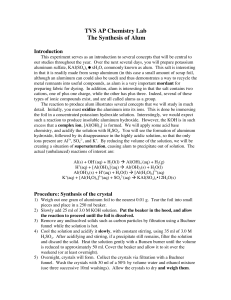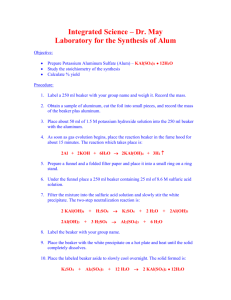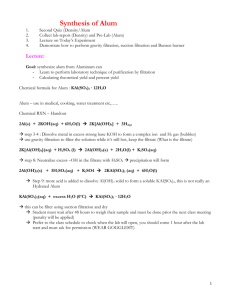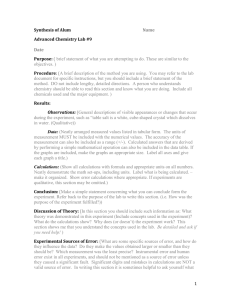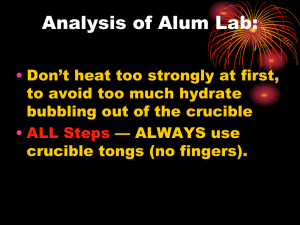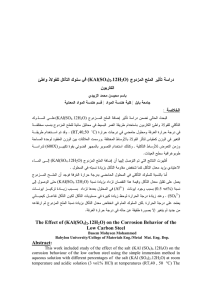Q-Alum - Personal.psu.edu
advertisement
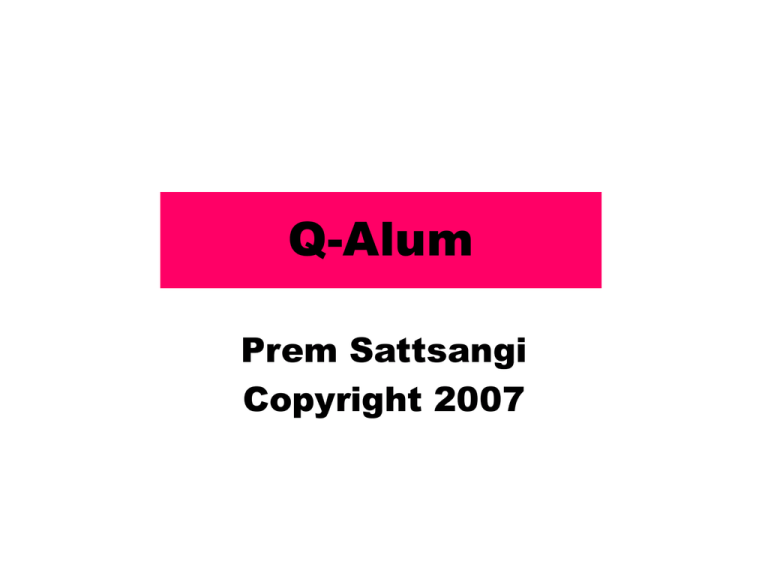
Q-Alum Prem Sattsangi Copyright 2007 Corrosion of metals (Reaction of a metal with Oxygen) • Aluminum and Iron, both get oxidized to form Cations with +3 charge. • Al Al3+ + 3e• Fe Fe3+ + 3e• With oxygen, they react to form similar oxides: • 4Al(s) + 3O2(g) 2Al2O3(s) Forms a THIN protective coating and prevents further oxidation. • 4Fe(s) + 3O2(g) 2Fe2O3(s) (known as RUST) • Rust is porous. Iron continues to rust. #1 Alum • Explain the term alum • A Complex salt formed by combination of aluminum sulfate and a Gr. IA metal or ammonium sulfate. • Write the formula of: Ammonium alum NH4Al(SO4)2.12H2O Lithium alum LiAl(SO4)2.12H2O Common alum KAl(SO4)2.12H2O #2 What is the formula of? Ammonium ion NH4+ Sulfate ion SO42- Ammonium sulfate (NH4)2SO4 Potassium Hydroxide KOH Aluminum hydroxide Al(OH)3 Potassium aluminum hydroxide KAl(OH)4 Potassium aluminum sulfate KAl(SO4)2 #3 Write The Redox Reaction when Al(s) reacts with KOH(aq). Al(s)+ KOH(aq) + H+OH- Ox.# = 0 = +1 KAl(OH)4(aq) + H2(g) Al3+ Ox.# = 0 (1 Al Al3+ + 3e-) Al(s)+KOH(aq)+3H2O(l) KAl(OH)4(aq) + 1.5H2(g) (Hint: 3H+ + 3e- 3H =1.5H2) 2Al(s)+2KOH(aq)+ 6H2O(l) 2KAl(OH)4(aq) + 3H2(g) Check: 2Al (getting oxidized) 2Al3+ + 6e6H+ + 6e- (getting reduced) 3H2 #4 Amphoteric Aluminum hydroxide Reacts with acid as well as with base. Most Hydroxides are: Basic, Fe(OH)3(s) + KOH(aq) No reaction Fe(OH)3(s) + 3HCl(aq) FeCl3(aq) + 3H-OH(l) Al(OH)3(aq) + 3HCl(aq) AlCl3(aq) + 3H-OH(l) Al(OH)3(aq) + KOH(aq) K+(aq) + [Al(OH)4]-(aq) React with Al(OH)3(aq) is Basic as well as Acidic. It is AMPHOTERIC. acid #5 Complete the Following Equations 2Al(s) + 2KOH(aq) + 6H2O Al(OH)3(aq) + KOH(aq) 2KAl(OH)4(aq) + H2SO4(aq) 2Al(OH)3(s) + 3H2SO4(aq) + D 2KAl(OH)4 (aq) + 3H2 KAl(OH)4(aq) 2Al(OH)3(s) + K2SO4(aq) Al2(SO4)3(aq) + 6HOH (l) Al2(SO4)3(aq) + K2SO4(aq) + 24H2O 2KAl(SO4)2.12H2O #6 Theoretical and %yield (p.107) Given the following information: Aluminum to Alum Formula Al KAl(SO4)2.12H2O FW 27 474 Mass of Aluminum = 0.0345 g EXPERIMENTAL YIELD OF ALUM = 0.4159 g Calculate Theoretical yield of alum: = 0.0345g Al x 1mol Al x 1 mol Alum x 474 g Alum 26.99 g Al 1 mol Al 1 mol Alum = 0.6056 g Alum Calculate %Yield: = 0.4159 g x 100 0.6056 = 68.7% #7 Electrical Energy from Aluminum. 2Al + 3O2 Al2O3 + 1670 kJ kwh] [3.6x103 kJ = 1 Aluminum 4.25g can be used to light a 0.025 kw bulb for how many hours. USE Unit Conversion Factors to calculate. 4.25g Al x 1mol Al x 1mol Al2O3 x 1670 kJ x 1kwh______ 27g Al 2 mol Al 1mol Al2O3 3.6x103 kJ x 0.025 kw = 1.5 h
